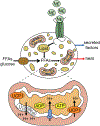Brown adipocytes from induced pluripotent stem cells-how far have we come?
- PMID: 31573081
- PMCID: PMC7078043
- DOI: 10.1111/nyas.14257
Brown adipocytes from induced pluripotent stem cells-how far have we come?
Abstract
A global increase in the number of individuals who are either overweight or obese is leading to a higher incidence of type 2 diabetes (T2D). Behavioral interventions for the treatment of obesity have yet to deliver desired outcomes, thus introducing a pressing need for molecular- and cellular-based therapies. Excess energy from food is stored in the form of triglycerides in white adipose tissue, which expands during weight gain and can lead to insulin resistance and T2D. By contrast, brown adipose tissue (BAT) releases energy from metabolic substrates in the form of heat and secretes factors that can reverse metabolic disease by acting systemically. Therefore, the ability to increase BAT activity is a promising approach to improve energy balance and metabolic homeostasis. Methods are now being developed to generate brown adipocytes from human induced pluripotent stem cells (hiPSCs), which would (1) provide an unlimited source of cellular material to study human brown adipogenesis, and (2) could be used to develop drug- and cell-based therapies for the treatment of metabolic complications associated with obesity. This article reviews basic BAT biology and details the current progress toward developing brown adipocytes from hiPSCs.
Keywords: UCP1; adipogenesis; brown adipocytes; diabetes; mesoderm; metabolic syndrome.
© 2019 New York Academy of Sciences.
Conflict of interest statement
Competing interests
The author declares no competing interests.
Figures



References
-
- Hales CM, C. M, Fryar CD, Ogden CL. 2017, October Prevalence of Obesity Among Adults and Youth: United States, 2015–2016. NCHS Data Brief. No. 288. - PubMed
-
- Ogden CL, C. M 2010, June Prevalence of Overweight, Obesity, and Extreme Obesity Among Adults: United States, Trends 1960–1962 Through 2007–2008. National Center for Health Statistics.
-
- U.S. Dept of Health and Human Services. Centers for Disease Control and Prevention. 2017. National Diabetes Statistics Report.
Publication types
MeSH terms
Grants and funding
LinkOut - more resources
Full Text Sources
Other Literature Sources

